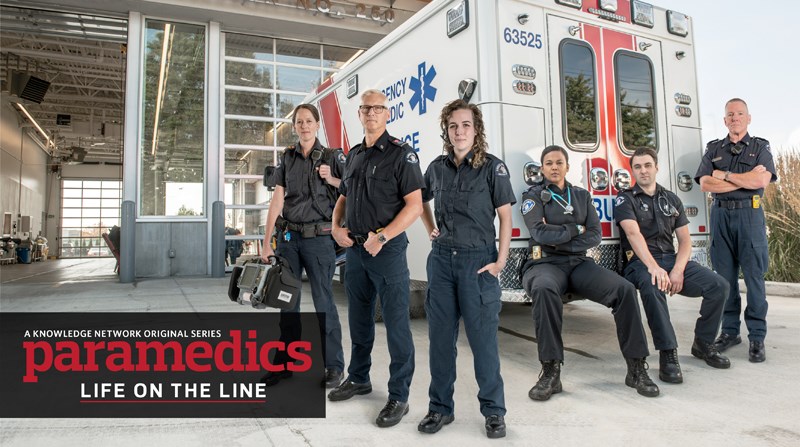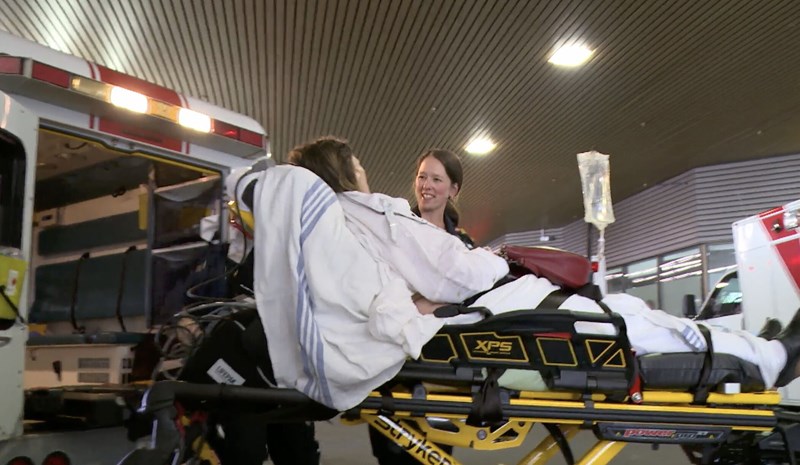Imagine collapsing on a busy street and waking up to paramedics asking you questions in a language you don’t understand.
You’re in pain and you want to tell them what happened, but you can’t.
In Burnaby, home to Metro Vancouver’s third largest population of recent immigrants, that’s not an unlikely scenario – and paramedics have to be prepared to deal with it.
“Hopefully someone’s there that can help,” B.C. Ambulance Service paramedic Jade Munro tells the NOW. “We often use bystanders if the patient’s comfortable with that. We ask first if they’re OK with it. And, of course, family members and young children are usually our best bet. If there’s a young child in the house – like age five and older – they can really help us because they’re usually bilingual.”

Munro and other Metro Vancouver paramedics are currently being featured in an original 10-episode Knowledge Network series, Paramedics: Life on the Line, and the latest episode (Episode 4) captures some of the language barriers they face during their life-saving work.
“It’s definitely challenging,” says Munro, who works out of a station just across the Vancouver border but responds to calls in Burnaby.
One tool paramedics have to communicate with their patients is the “language line” – a service that gives them access to phone interpreters for about 200 different languages and dialects within an average of 31.5 seconds once a specific language is named.
After a dispatcher puts her through to the service, Munro puts her phone on speaker.
“Say I have a Mandarin translator, I’ll speak with the Mandarin translator on the phone, saying, ‘Hey, I’ve got a patient. I want to ask her some specific questions about her chest pain.’ Then he or she asks the patient; the patient answers, and then he or she relays it back to me – so everything takes twice as long, but we can get through the call,” Munro says.
Things get tricky, though, when the patient speaks a less common language or an obscure dialect.
“The first challenge is to figure out what language they speak,” Munro says.
She recalls one patient whose African language no one was able to figure out before Munro’s part in the call was over.
When that happens, Munro says paramedics are forced to rely on what she calls “veterinary medicine”: examining the patient and checking vital signs.
Fortunately, she says, those can tell a paramedic plenty about whether the patient’s condition is life-threatening.
“If we can’t find abnormal vital signs or abnormal physical presentation, it’s not life-threatening in that moment,” she says, “so then we have the time to take them to the hospital and sort out the whole language thing.”
Changing attitudes
But being able to communicate with patients is important to the quality of their care, says Kiran Malli, director of Provincial Language Services, a Burnaby-headquartered program of the Provincial Health Services Authority that provides interpreting services to health authorities and doctors’ offices around the province.
The language line, a service provided by Ontario company 911 Interpreters Inc., is an important part of that, she says.
“In these emergency situations, if you have an interpreter on time, as needed, the care will be that much better,” she says. “Paramedics are part of the health-care system, so we want to make sure that they are able to do their job as effectively as they can for everybody out there. Just because I speak English, I shouldn’t get better results than somebody who doesn’t speak English.”
As the number of new immigrants and refugees in the region has grown, more health-care providers have adopted that attitude, according to Malli.
She says increased use of services like the language line bears that out.
Over the last five years, total calls have nearly doubled, from 16,578 in 2014 to 32,659 in 2018.
(Calls from paramedics during that time have gone up from 2,406 to 3,712.)
The total cost of the service, meanwhile, has jumped from $230,976 in 2014 to $496,301 last year.
To watch episodes of Paramedics: Life on the Line – which has been described as the unofficial prequel to Emergency Room: Life and Death at VGH – visit www.knowledge.ca/program/paramedics.



